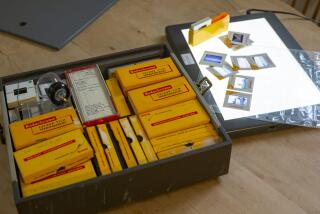‘The Next Tsunami’ examines our short-term memory about disasters
“It seems that the more ‘advanced’ a society becomes, the shorter its memory,” suggests geologic oceanographer Chris Goldfinger late in Bonnie Henderson’s riveting “The Next Tsunami: Living on a Restless Coast.” “Native Americans not only have a memory of the last Cascadia earthquake 311 years ago, they have a memory of the explosion of Mount Mazama about 7,600 years ago. We, on the other hand, can’t remember much that happened before Twitter and Facebook.”
What Goldfinger is getting at is the issue of collective memory, which increasingly beguiles us the further from a collective we become. This has long been the challenge for geologists, that in our relentless striving for the future, we tend to forget, if not erase outright, our knowledge of the past.
Such a tension occupies the center of “The Next Tsunami,” which is by turns a story of obsession, a geologic mystery and an inquiry into how we deal with disasters — or, more often, don’t. Beginning with an account of the tsunami that struck the Oregon coast on March 27, 1964, in the wake of that day’s 9.2 Alaska earthquake, the book explores the decades of research (seismological, historical and anthropological) that enabled scientists to discover an earlier temblor: the 9.0 Pacific Northwest quake of Jan. 26, 1700, which caused a tsunami that devastated coastal regions in Japan.
If this sounds like ancient history, it is and it isn’t, because one thing we know about earthquakes (and, by extension, tsunamis) is they’re cyclical. To highlight that, Henderson wisely builds “The Next Tsunami” around people — most essentially Tom Horning, who as a 10-year-old witnessed the 1964 tsunami in his hometown of Seaside, Ore., and grew up to be a geologist absorbed by helping his friends and neighbors prepare for the next one.
This, of course, is hardly a new narrative strategy; it brings to mind John McPhee, whose “Annals of the Former World” is a precursor of sorts to “The Next Tsunami,” offering a geologic history of North America through the eyes of the geologists who decoded the terrain. But it’s as effective here as it is in McPhee’s work because it personalizes the science, which lets us go places that as readers we might not otherwise be willing to go.
Horning is a case in point: a local kid who struggled to find himself, stymied by colorblindness, painting houses to pay his way through graduate school, wrestling with family strife. Henderson portrays him as a geologic everyman, transfigured by that one great experience of the ineffable, watching the tsunami pour in.
“He was about two hundred feet from the bank when he saw water begin to spill out of the channel and move toward him,” she writes. “Nothing dramatic: the water just crept across the sand flats in one long, low, relentless surge … Some of the debris that had floated into the estuary on the retreating wave the previous night — logs, appliance, pieces of the Fourth Avenue Bridge, which had been demolished by the tsunami — was now rolling and tumbling on the waves, gyrating as if the bay were boiling.”
Henderson articulates an important double vision: the way disasters both thrill and terrify us. Nobody who has ever been through one can ever shake the wonder, which is what drives not only Horning but also every scientist in the book. The search for that last great Cascadia temblor, it turns out, overlaps almost exactly the rise of plate tectonics, which changed the way we think of earthquakes and how they interact. At the same time, it stretches beyond traditional geologic boundaries, involving ethnography, mythology, carbon dating, forestry.
Among the researchers we meet are Goldfinger, whose studies of the ocean floor helped to extend the geological record, “and the longer the record, the more scientists would know about recurrence rates for Cascadia’s great quakes.” Or University of Michigan geophysicist Kenji Satake, who stunned a 1994 conference by becoming the first person to posit a date for the 1700 event based on his research into tsunami records from Japan.
This is important for a few reasons, not least that, before this quake was discovered — “in the Christopher Columbus sense of the word,” Henderson reminds us: “it had been there all along” — the Cascadia subduction zone was considered dormant, its dangers ignored. Yet even more compelling is the recognition of the earth as a living planet, in which all things are connected and we live at the mercy of great forces we can’t control.
Henderson makes this explicit when she describes a geologist named Rob Witter, experiencing an aftershock of the 2010 Chilean earthquake. “It was like riding a train rumbling across an endless plain,” she writes. “… But it wasn’t a train. It was the Earth. And never had Rob felt so in touch with the Earth, so coupled to it.”
This is Horning’s feeling also, although like Goldfinger, he is ultimately frustrated by our pervasive willingness to forget. Even in the wake of the catastrophic 2011 Japan earthquake and tsunami — which Henderson includes but smartly chooses not to emphasize — we continue to exist as if these situations will never happen to us, as if the earth were stable and secure.
“How can you write a book about a disaster that hasn’t happened yet?” a friend asks Henderson, but that’s the point precisely, to understand that earthquakes and tsunamis, that all natural disasters, are part of the ongoing story the planet tells.
“The land is talking to you all the time!” Horning reflects, as he watches the news reports from Japan. “It’s an interesting language. If God talks to us, he does it through natural forces.... It’s loud and clear. I wish other people would listen.”
The Next Tsunami
Living on a Restless Coast
Bonnie Henderson
Oregon State University Press: 320 pp., $19.95 paper
More to Read
Sign up for our Book Club newsletter
Get the latest news, events and more from the Los Angeles Times Book Club, and help us get L.A. reading and talking.
You may occasionally receive promotional content from the Los Angeles Times.







